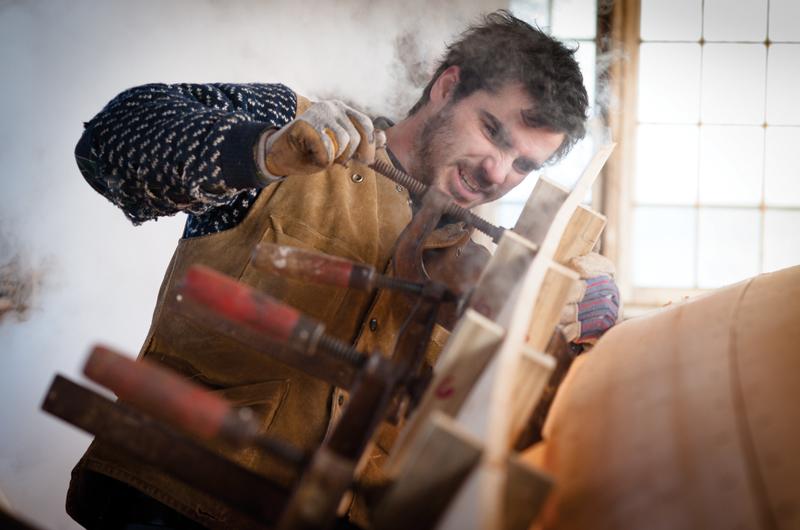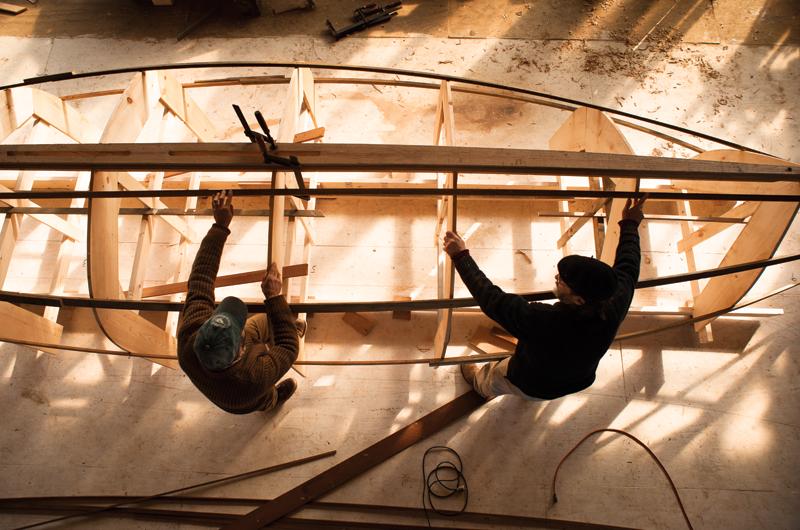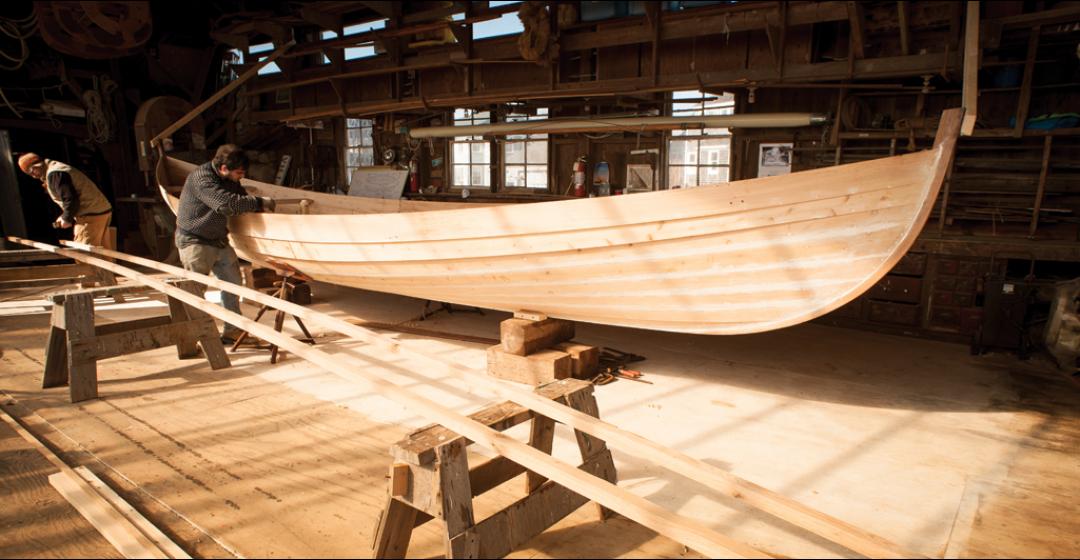Dozens of vessels of all sizes, shapes, and degrees of refinement have slipped into the water from the Gannon and Benjamin Marine Railway over the past three-and-a-half decades, so you might think that Ross Gannon and Nat Benjamin, the founding builders of the boatyard, have seen pretty much all there is to see in the manner of wooden boat construction. The boats of Gannon and Benjamin all have been built the old way, by skilled hands from rough wood. But when the call came in 2012 from Mystic Seaport in Connecticut asking if the yard might build an exact replica of a whaleboat to specifications from the famous Beetle boatbuilding shop in New Bedford, the craftsmen at Gannon and Benjamin came to see pretty quickly that the Beetle Boat Yard had come up with one darned confounding way to build a boat.
The method was batten-seam construction, meaning that instead of building the ribs first and installing the skin second, the builders had to shape the cedar skin of the hull around a parade of wooden molds and install the interior skeleton afterward. This involved notching some seventy sets of closely spaced white oak frames over long lengths of curved interior planking, called battens, that reinforce the hull. Slow and tiresome work.
“All of us keep shaking our heads: ‘What a weird way to build a boat!’” said Gannon. “And they had to have done it this way for a reason. I would love to talk with the old guys if they were still around – why they chose to do it this way.”
As he and several young colleagues built the whaleboat over the course of six months last year, he had time to give the matter some thought. “Well, she’s lightweight,” he said. “They all had to be light because they had to be fast. Whether they were rowing or sailing or whatever, they had to really go through the water well to catch these leviathans. So speed was essential. Of course, the lighter you build a boat, the weaker it is. But they had to be reasonably strong, so that’s how they developed this rather peculiar construction.”

The Beetle boat yard also had to be ready to turn out a whaleboat fast when a commission from a whaling magnate came in, and the company developed an early form of mass production. Whereas the shipwrights in Vineyard Haven in 2013 had to measure, cut, bend, taper, fit, and fasten every piece individually, the boatbuilders of New Bedford built everything in advance, over and over, waiting for whaleboat orders to come in.
“See, they had patterns for all the planking, for every piece of wood on the boat,” said Benjamin. “So if they didn’t have an order, they could just make pieces to the puzzle. Have them all stacked up. Then, when they got an order, they could bang it together pretty quickly. . . . There’s a story about one particular rush job where they had everything made and they actually put one together in forty-eight hours. Now, I don’t know if that’s apocryphal or not.”
When the whaleship Charles W. Morgan ties up in Vineyard Haven this June for the first time in her astonishingly long and lucky career, observers and visitors will thrill to the height and complexity of her rigging, the stoutness of her timbers, the fury and brutality of the processes on deck that once rendered oil from a newly slaughtered whale. But as arresting as all these things will be, it was in slender whaleboats such as the one built here – one of nine constructed at various boatyards around the country for the Morgan – that the truly harrowing work of hunting and killing leviathans was done.
Every move counted when making a final approach to a whale, which could be larger than a dozen elephants and as apt as any creature to become enraged when stabbed in the back. On calm days, the men rowed only when the whale spouted, lest the noise of the oars spook the prey and spoil the hunt. The final strokes were made with canoe paddles, with the harpooner standing ready in the bow, hoping for a chance to sink his razor sharp dart “up to the hitches,” or two-and-a-half feet into the blubber of the beast. The best location was just behind the head, and there was always a second harpoon attached to the line, which the harpooner tried to get into the whale as well. If he didn’t, he threw it quickly overboard, lest it get whipped around the boat by the exiting line.
As soon as the whale was struck, the call was “stern all” and the men backed away from the wounded whale as rapidly as possible. The first hundred feet of line were coiled separately from the rest to allow the whale to get clear of the boat before it felt any resistance. The remaining thousand feet or so ran through a guide at the bow to a post at the stern, around which it was wrapped several times to create drag. When the wounded whale took its initial dive, the line tore out of the tubs in the waist of the boat so fast that the friction could cause the drag post to burst into flames. Flying coils of rope regularly ripped off hands or arms, or took men down several hundred feet before anyone else even knew their boatmate was in trouble. A knot in the rope could catch in the guide and take the whole boat down,
and the harpooner always kept a hatchet in the bow to cut the line if he must.

Most whales came to the surface after an initial dive and swam hard on the surface, towing the boat behind it at upwards of ten or twelve knots. At that speed, even six strong men couldn’t pull line in, and only when the fifty-ton engine tired could they close in for the kill. Now the most experienced member of the crew, the boatsteerer in the stern, switched places with the harpooner in the bow and picked up the killing lance. The lance had a socket with which to extend the handle, and the goal was to drive it all the way under the shoulder blade to the vitals and churn it up and down. This was the time when the massive flukes thrashed, potentially smashing the boat to pieces, and when sperm whales typically rolled over and fought on their backs so that their massive jaws could smack open and shut. This was also when sharks by the hundreds joined in the fray, attracted by the prodigious blood in the water.
If all went well for the whalers and they got back to the ship with their prey, the danger was largely past. But the work was only beginning. “All hands strip down to a shirt, a pair of overalls rolled up to the knees, showing a pair of bare shins and sockless feet in large brogans,” remembered a whaler, “and in we go – grease from head to foot – day and night until the whale is all cut safely on board. It gives you a funny sensation at first to get into a deck full of blubber, with the slimy stuff around your exposed cuticle, and oil squashing out of your shoes at every step.”
For the young men who built a new whaleboat for the Morgan at the Gannon and Benjamin boatyard, there was nothing archaic about the work. To them, building wooden boats, plank on frame, remains a living and relevant enterprise.
“I don’t really like to think that we’re carrying on a tradition; I don’t really like to look at it that way,” said Matthew Hobart, who came to the Vineyard from San Francisco. “What we do here we do because we want to do it, and we do it with the best materials that we can get, and we try and build boats as best we can, so that they’re safe and they’re strong. We’re not trying to emulate what people did in the past. In this situation we are trying to replicate [things] to a certain degree. But I think the tradition is just the fact we do it.”
First-time boat builder Nat Quinn said he was amazed that, for all the care invested in the design and construction back in the day, a whaleboat took such a beating that nobody really expected it to last more than one voyage.
“I’ve been thinking about the irony of it,” he said. “Somebody who walks into the shop – people do it all the time – and they look at this amazing, lasting thing we’re doing, and holding on to old skills, and [actually] you’re building a boat that was like IKEA furniture back in the day! This boat was built to be disposable. It’s hilarious with everyone walking in and thinking it’s the most lasting thing ever. No, actually, it was supposed to be trashed!”
The writer thanks Virginia Crowell Jones for help with research for this story.
Do You Smell What I Smell?
When Herman Melville made his way to New Bedford in 1841 to sail on the Acushnet under the Vineyard captain Valentine Pease, the first clue he may have had that he was close to his destination may have been, frankly, the smell. The whaling industry was the precursor to the oil industry of today, and the ships in particular, were, well, smelly. As the writer A. Hyatt Verril described the olfactory situation in his book The Real Story of a Whaler, “the majority [of ships] were slipshod, dingy, weather-beaten; bearing scars of countless battles with wind and sea, reeking with oil and grease and smelling to high Heaven. The old saying that a sailor can ‘smell a whaler twenty miles to windward’ is scarcely an exaggeration. Betwixt catching, killing, cutting in, and boiling, the whalemen found little time to keep their vessels ship-shape.”
So when the newly re-minted Charles W. Morgan visits the Vineyard this summer, replete with all the trappings of a whaling ship of her day, you’ll find ample crew to hoist the sails, steer the ship, man the boats, and strike out for their prey. You’ll see the try-pots for boiling oil, and perhaps the pens on deck to house livestock. The weapons used to kill whales and the tools used to butcher them will be there: harpoons, lances, and flensing tools used to strip the animal of its blubber.
But unless Mystic Seaport can find thirty men and boys who haven’t bathed for months, a number of goats, pigs, chickens, and maybe a few Galápagos tortoises, and unless they actually kill a whale somewhere in Long Island Sound and tie it to the ship and float around a while letting all the scents combine and fester, you will not, fortunately or otherwise, have a complete aromatic picture of what went on so far out at sea so long ago.
Even Melville, if he could visit the Morgan in port today, might not be disappointed by the absence of smoke from the try-pots, which he said “has an unspeakable, wild, Hindoo odor about it, such as may lurk in the vicinity of funereal pyres. It smells like the left wing of the day of judgment; it is an argument for the pit.”
Given the olfactory reputation of whaleships, it’s perhaps ironic that the most prized product that came from all the slaughter, blood, and guts was ambergris. The mysterious substance that Melville described as “handfuls of something that looked like ripe Windsor soap, or rich mottled old cheese; very unctuous and savory withal,” was found deep in the bowels of the beast and was the best available ingredient to set the scent in fine perfumes and colognes, which of course were used to hide, well, smell.
Melville himself put it this way: “Who would think that such fine ladies and gentlemen should regale themselves with an essence found in the inglorious bowels of a sick whale! Yet so it is.”
The Morgan brings history to life. Almost. But almost might just be a good thing.
– Joe Keenan
The Wit and Wisdom of Cap’n George Fred Tilton
After the Morgan was retired to a sand berth in Fairhaven, Massachusetts, a legendary Chilmark whaling captain regaled the tourists with stories from the deep and a dose of local flair.
On Intelligence: “Don’t let anybody ever tell you that a whale don’t know anything.”
On Education: “Of course I went to school as soon as I was old enough, but I didn’t go much.”
On Wealth: “After being at sea fourteen months...I left the ship considerable bigger and stronger than I was when I went aboard. I was also richer in experience, and darned little else, for I owed the ship thirty-five dollars.”
On Fashion: “I wish you could have seen them clothes...as I started for Martha’s Vineyard I looked just like Peleg W. Pillsbury of Oldtown, Maine.”
On Economics: “It was really the whalebone which counted on Arctic voyages. There’s no market for it nowadays. No use to go into details, but women are responsible for its depreciation in value.”
On Whales and Whalers: “The whale is a peculiar animal, never fully understood, and the men who were successful in catching him had to be more or less peculiar too. If they weren’t born that way, the life they led would make them so.”
On Health: “One sunny day the old man came on deck, wrapped in a blanket, and sat down in an easy chair. He looked as if he had one foot in the grave and the other one on a banana peel. As he sat there Kellis came along…and the old man asked him how he felt. Kellis replied that he didn’t feel very bad and guessed ‘t was only ‘the old whiskey working out.’ Sick as he was, the captain had to laugh...We found out later that what we had was measles.”
On Religion: “Captain Slocum was one of those sanctimonious fellows – belonged to the church and wouldn’t sail on Sunday. He’d work like the devil to get away Saturday night, and then, of course,
we had to keep going.”
On Masculinity: “Captain Nelson therefore advised me to two of his natives, Tickey and Canuanar, man and wife...I agreed to do this and never felt sorry. Tickey was a good man, and his wife was twice the man that he was.”





